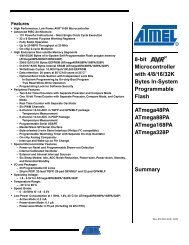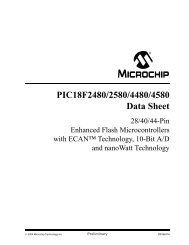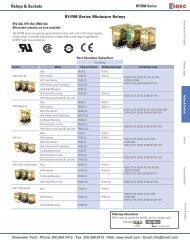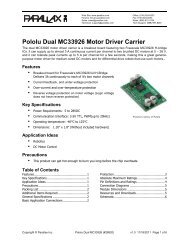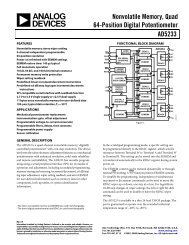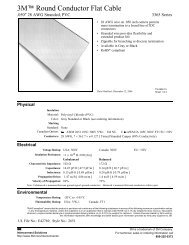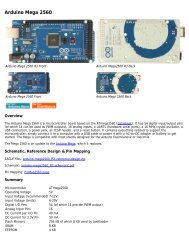FLEX 10KE Embedded Programmable Logic Device Data Sheet
FLEX 10KE Embedded Programmable Logic Device Data Sheet
FLEX 10KE Embedded Programmable Logic Device Data Sheet
You also want an ePaper? Increase the reach of your titles
YUMPU automatically turns print PDFs into web optimized ePapers that Google loves.
<strong>FLEX</strong> <strong>10KE</strong> <strong>Embedded</strong> <strong>Programmable</strong> <strong>Logic</strong> <strong>Device</strong>s <strong>Data</strong> <strong>Sheet</strong><br />
On all <strong>FLEX</strong> <strong>10KE</strong> devices (except EPF10K50E and EPF10K200E devices),<br />
the input path from the I/O pad to the FastTrack Interconnect has a<br />
programmable delay element that can be used to guarantee a zero hold<br />
time. EPF10K50S and EPF10K200S devices also support this feature.<br />
Depending on the placement of the IOE relative to what it is driving, the<br />
designer may choose to turn on the programmable delay to ensure a zero<br />
hold time or turn it off to minimize setup time. This feature is used to<br />
reduce setup time for complex pin-to-register paths (e.g., PCI designs).<br />
Each IOE selects the clock, clear, clock enable, and output enable controls<br />
from a network of I/O control signals called the peripheral control bus.<br />
The peripheral control bus uses high-speed drivers to minimize signal<br />
skew across the device and provides up to 12 peripheral control signals<br />
that can be allocated as follows:<br />
■<br />
■<br />
■<br />
■<br />
Up to eight output enable signals<br />
Up to six clock enable signals<br />
Up to two clock signals<br />
Up to two clear signals<br />
If more than six clock enable or eight output enable signals are required,<br />
each IOE on the device can be controlled by clock enable and output<br />
enable signals driven by specific LEs. In addition to the two clock signals<br />
available on the peripheral control bus, each IOE can use one of two<br />
dedicated clock pins. Each peripheral control signal can be driven by any<br />
of the dedicated input pins or the first LE of each LAB in a particular row.<br />
In addition, a LE in a different row can drive a column interconnect, which<br />
causes a row interconnect to drive the peripheral control signal. The chipwide<br />
reset signal resets all IOE registers, overriding any other control<br />
signals.<br />
When a dedicated clock pin drives IOE registers, it can be inverted for all<br />
IOEs in the device. All IOEs must use the same sense of the clock. For<br />
example, if any IOE uses the inverted clock, all IOEs must use the inverted<br />
clock and no IOE can use the non-inverted clock. However, LEs can still<br />
use the true or complement of the clock on a LAB-by-LAB basis.<br />
The incoming signal may be inverted at the dedicated clock pin and will<br />
drive all IOEs. For the true and complement of a clock to be used to drive<br />
IOEs, drive it into both global clock pins. One global clock pin will supply<br />
the true, and the other will supply the complement.<br />
When the true and complement of a dedicated input drives IOE clocks,<br />
two signals on the peripheral control bus are consumed, one for each<br />
sense of the clock.<br />
32 Altera Corporation



